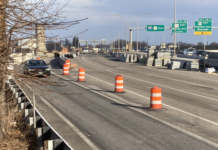WASHINGTON – More than two-thirds of U.S. roadways are in need of repair and the poor condition of the nation’s transportation network results in billions in extra costs, according to a White House report.
And leading the way are Rhode Island and Connecticut, with 41 percent of their roads considered to be in “poor condition,” compared with a national average of 14 percent.
The report was released Monday in conjunction with President Barack Obama’s campaign to pressure Congress for a deal to replenish the Highway Trust Fund. The fund, supplied by fuel taxes, is heading toward insolvency as early as next month, jeopardizing jobs and projects during the peak construction season.
Crumbling roads and bridges cut into economic growth, by increasing transportation costs and delaying shipments, according to the report.
“A well-performing transportation network keeps jobs in America, allows businesses to expand, and lowers prices on household goods to American families,” said a 27-page report by the Council of Economic Advisers and National Economic Council.
In Rhode Island, 41 percent of the state’s 6,484 miles of public roads are in poor condition, the report found, and as many as 3,595 jobs could be jeopardized if the Highway Trust Fund is not replenished. Connecticut has a total of 21,414 miles of public roads.
The report also noted that 57 percent of the Ocean State’s 766 bridges were considered “deficient or obsolete,” the highest percentage in the United States, compared with a national average of 25 percent. The state with the second-highest percentage of deficient or obsolete bridges was Massachusetts, at 52 percent.
Roads in the rest of New England were generally in much better shape than in Rhode Island and Connecticut, with Massachusetts being judged to have 19 percent in poor condition, Maine 7 percent, New Hampshire 17 percent and Vermont 14 percent.
Bridges were another matter, however. Connecticut was judged to have 35 percent deficient of obsolete, Maine 33 percent, New Hampshire 32 percent and Vermont 33 percent.
Road R&D
Obama is scheduled to speak Tuesday at a highway research center in McLean, Va., that tests technology to make road and bridge building more efficient. Later in the week, the president travels to Delaware to announce a new way to increase private sector investment in transportation projects, the White House said in a statement.
States should expect the federal government to begin slowing payments as early as Aug. 1 to help stretch out funding for road, bridge and transit projects, Transportation Secretary Anthony Foxx has said. Construction delays threaten 112,000 transportation projects and about 700,000 construction jobs, Vice President Joe Biden told business leaders at the White House last week.
“The moment is dire,” according to Foxx. The trust fund “is quickly running toward insolvency.”
Current transportation funding law expires Sept. 30.
Congressional proposals
The House and Senate are preparing legislation to shore up transportation funding on a short-term basis through May 2015, and lawmakers said votes may come as soon as Tuesday.
The House and Senate proposals both generate almost $11 billion, according to Congress’s Joint Committee on Taxation. They include increased customs fees, changes to pensions that lower companies’ short-term contributions, and revenue from a leaking underground storage tank fund. The Democratic-led Senate version, though, contains other tax provisions that may be obstacles in the Republican-controlled House.
Lawmakers haven’t acted on Obama’s proposed a four-year, $302 billion plan, where about half the funding would come from an increase in the federal excise tax on motor fuels and the rest from revenue obtained by closing tax breaks for corporations, including taxing overseas earnings.
Governors lobby
Republican and Democratic governors meeting in Nashville, Tenn., over the weekend said lawmakers, at a minimum, should approve a short-term fix before the federal highway account runs dry. They also called for a long-term resolution to prevent uncertainly that could stop or delay projects worth an estimated $3.6 trillion to fix crumbling roads and bridges.
“These sort of half-solutions, kicking the can down the road, short-term sorts of things, this is not a way to inspire business confidence or consumer confidence,” Maryland Governor Martin O’Malley, a Democrat, said in an interview. “Some of these investments are multiyear investments that require multiyear funding streams.”
Companies such as Caterpillar Inc., United Parcel Service Inc. and Honeywell International Inc., are pushing for a long- term solution to infrastructure funding.
The White House economic study on transportation and infrastructure said U.S. investment in the quality of roads has fallen to 18th from 7th in the past decade, compared with overseas competitors.
White House economists said 65 percent of U.S. roads are rates in less than good condition, and one in four U.S. bridges “require significant repair or cannot handle today’s traffic.”
The federal government accounted for 27 percent of highway and transit spending in fiscal 2011, compared with 38 percent from states and 35 percent from local sources, according to the Pew Charitable Trusts in Washington.
To see the entire report, click HERE.












